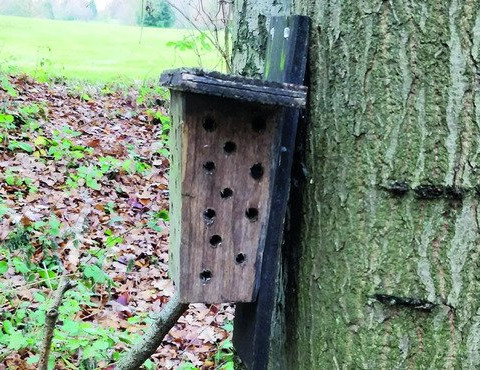Getting ready for spring
- Stephen Thompson

- Feb 28, 2021
- 4 min read
Updated: Mar 8, 2021
The summer months have gone again for another year and winter is upon us. But what does a lonely greenkeeper do now the grass has stopped growing and the weather turns a bit yucky? Conservation Greenkeeper at John O'Gaunt Golf Club, Steve Thompson, offers some suggestions.

What do you do when the course is too wet, frosted up or covered in snow? Now is the perfect time to help the local wildlife and prepare for spring.
One way you can help is by building nestboxes for birds - a perfect inside job for this time of year. But where do you start? There are so many different types and designs, different materials too, but I'm going to talk about what has worked for me at John O'Gaunt Golf Club.
Probably the easiest boxes to make to start with are small boxes for blue tits and great tits, which I base on a BTO design. I start with one sheet of 12mm shuttering ply/external ply from my local timber merchant. Its much easier if they can cut it up for you into long strips 150mm wide - you should get about seven strips. Each strip will make two boxes with this design. Measurements: back piece, 300mm, base 125mm, roof 210mm, sides are sloped for the roof, 1 side is 200mm the other 175mm and the front is 175mm.
On the front piece you just need to put an angle on the top for the roof to close and drill a hole for the birds. I suggest 25mm diameter for blue tits and coal tits and 32mm to cater for slightly larger birds, such as great tits and nuthatches.
I use 30mm sheradised panel pins to put the box together and brass hook and eyes to keep the lid closed and secure, both of which should be available from your local hardware store or builder's merchants. The brass hooks are usually easier to purchase on line from retailers such as Amazon or eBay.
You could also make small, open fronted boxes for robins. This follows a similar design to the boxes above but, instead of a hole drilled in the front, the front piece is a different size. For a robin, its 100mm instead of 175mm. Open fronted boxes like this are often difficult to get birds nesting in successfully as they are more open to predation, but they do get used.
I don't usually stain my small boxes, but you can if you want, I find they often last for several years without, some have lasted for up to twelve. Also, you can either nail/screw the boxes to the tree or use rubber straps to avoid damaging the tree. (also, chainsaw friendly).
One more box you can build is a bat box. Again, like the bird boxes, there are several different types and sizes you can make yourself or you can buy them.
It's not just birds and bats you can help during the winter. You can also provide homes for small insects, bees etc. by building a bug/insect hotel.
The simplest way is to recycle small logs you might have from tree work on the course. All you need to do is drill lots of different size holes in the log then hang it on a tree. You could do the same on a bigger scale and just stand the log up or lay it down. Another way is to take a simple nestbox design and, instead of putting a front on it, just fill it with cut up bamboo canes.
Wildlife to look for during the winter:
The obvious to start with is birds. If you have mountain ash and other berry laden bushes and trees, then you are quite likely to have winter visitors such as fieldfare and redwing, often seen in large numbers together with mistle thrushes and blackbirds.
If you're lucky, you might get a visit from a rare Scandinavian visitor - the waxwing, an unmistakable orangey coloured bird with a distinct crest, about the size of a starling.
Other birds you might want to look out for include brambling, redpoll, siskin and grey herons (often seen at John O'Gaunt in the winter on the fairways pecking for worms). Keep an eye out for footprints in muddy areas or even the snow, and maybe set up a trail cam to see what's lurking.
On mild days in the winter, it's possible to catch a glimpse of a Red Admiral butterfly. Small mammals are usually tucked away somewhere warm, but larger species can be seen. Keep a look out for deer, most probably muntjac but also roe or fallow. If you're lucky, you may see a fox and, if you have water on the course, maybe even an otter.
There is always something to do in the winter on a golf course. Helping our wildlife is just a small part of what I do and, hopefully, I've given you some ideas on what you can do too.
There are number of articles on the Pitchcare website that will help you - just use the search facility. Additionally, Pitchcare have recently launched their own ecology range of products, including bat and bird boxes, insect hotels and hedgehog houses.





















Comments